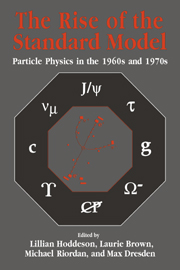Book contents
- Frontmatter
- Contents
- Contributors
- Editors' Acknowledgments
- Photographs of the Symposium
- Abbreviations and Acronyms
- Mathematical Notation
- Part One Introduction
- Part Two Quarks and Leptons
- Part Three Toward Gauge Theories
- Part Four Accelerators, Detectors, and Laboratories
- Part Five Electroweak Unification
- 23 The First Gauge Theory of the Weak Interactions
- 24 The Early History of High-Energy Neutrino Physics
- 25 Gargamelle and the Discovery of Neutral Currents
- 26 What a Fourth Quark Can Do
- 27 Weak-Electromagnetic Interference in Polarized Electron–Deuteron Scattering
- 28 Panel Session: Spontaneous Breaking of Symmetry
- Part Six The Discovery of Quarks and Gluons
- Part Seven Personal Overviews
- Index
27 - Weak-Electromagnetic Interference in Polarized Electron–Deuteron Scattering
Published online by Cambridge University Press: 03 February 2010
- Frontmatter
- Contents
- Contributors
- Editors' Acknowledgments
- Photographs of the Symposium
- Abbreviations and Acronyms
- Mathematical Notation
- Part One Introduction
- Part Two Quarks and Leptons
- Part Three Toward Gauge Theories
- Part Four Accelerators, Detectors, and Laboratories
- Part Five Electroweak Unification
- 23 The First Gauge Theory of the Weak Interactions
- 24 The Early History of High-Energy Neutrino Physics
- 25 Gargamelle and the Discovery of Neutral Currents
- 26 What a Fourth Quark Can Do
- 27 Weak-Electromagnetic Interference in Polarized Electron–Deuteron Scattering
- 28 Panel Session: Spontaneous Breaking of Symmetry
- Part Six The Discovery of Quarks and Gluons
- Part Seven Personal Overviews
- Index
Summary
In 1978 a team of twenty physicists performed an experiment at SLAC that demonstrated convincingly that the weak and electromagnetic forces were acting together in a fundamental process, the inelastic scattering of polarized electrons. This result showed that the electron was a normal partner in the model of electroweak interactions as first spelled out by Steven Weinberg in 1967.
The work I describe here was done mostly by other persons as part of a team effort. In this paper I have tried to give credit to the many excellent contributions from this group. I had hoped to point out all of the important individual efforts that were so critical to the overall success, but I feel that this summary falls short of that goal. This chapter should be taken as a personal recollection of the work that occurred over a period of eight years at SLAC, Yale University, and elsewhere.
As a part of this chapter, the organizers asked that I summarize the work in atomic physics to seek out parity-violating effects in atomic levels. I reluctantly agreed to attempt this, even though I had no involvement in those experiments. What I present here is only a brief history of the search for optical rotation by bismuth vapor, as reported in the literature. I have not attempted to extend this summary to cover the work on the other atoms – thallium, lead, and cesium – which came somewhat later.
- Type
- Chapter
- Information
- The Rise of the Standard ModelA History of Particle Physics from 1964 to 1979, pp. 459 - 477Publisher: Cambridge University PressPrint publication year: 1997



